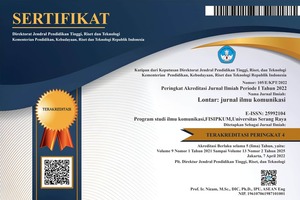Representation of Alone Together in Family Communication in the Film " Nanti Kita Cerita Tentang Hari Ini"
DOI:
https://doi.org/10.30656/lontar.v11i1.5842Keywords:
Family Communication, Film, Alone Together, Representation, SemioticsAbstract
Komunikasi keluarga yang efektif menjadi dasar untuk terciptanya keluarga yang baik. Keluarga yang gagal dalam menciptakan pola komunikasi yang baik dapat memunculkan ketidakseimbangan dalam komunikasi antar anggota keluarga tersebut. Hal ini memicu adanya alone together seperti yang direpresentasikan oleh keluarga dalam film “Nanti Kita Cerita Tentang Hari Iniâ€. Penelitian ini bertujuan untuk mengkaji adanya fenomena alone together tersebut dalam film “Nanti Kita Cerita Tentang Hari Iniâ€. Alone together sendiri merupakan keadaan di mana seseorang akan merasa sendirian meskipun sedang berada di tengah keramaian. Manfaat dari penelitian ini yaitu untuk mempelajari fenomena alone together yang ada di sekitar kita, terutama dalam keluarga. Penelitian ini menguak representasi film dengan menggunakan metode penelitian kualitatif, yaitu semiotika oleh John Fiske. Analisis semiotika ini memiliki tiga level, yaitu level realitas, level representasi, dan level ideologi. Hasil analisis dari ketiga level tersebut adalah rupanya film “Nanti Kita Cerita Tentang Hari Ini†menunjukkan fenomena alone together yang dialami oleh beberapa anggota keluarga. Perasaan alone together ini dipicu oleh pola komunikasi keluarga monopoli atau otoriter.
References
Andhani, W., & Putri, I. P. (n.d.). REPRESENTASI PERAN IBU SEBAGAI SINGLE PARENT DALAM FILM “SABTU BERSAMA BAPAK†(ANALISIS SEMIOTIKA JOHN FISKE DALAM FILM “SABTU BERSAMA BAPAKâ€) A REPRESENTATION OF A MOTHER’S ROLE AS A SINGLE PARENT IN THE FILM “SABTU BERSAMA BAPAK†(ANALYSIS OF SEMIOTICS JOHN FISKE IN THE FILM “SABTU BERSAMA BAPAKâ€) (Study on Students Telkom University).
Anshori, H. (2020). HUBUNGAN KOMUNIKASI INTERPERSONAL DENGAN Pendahuluan. Skripsi, 1, 1–86.
Ardiansyah, Y., Susanto, D., & Workstation, D. A. (n.d.). IMPLEMENTASI TEKNIK SURROUND SOUND PADA MIDI UNTUK BACKGROUND SOUND PADA VIDEO BERGENRE SCIENCE FICTION Program Studi Teknologi Multimedia Broadcasting – Politeknik Elektronika Negeri Surabaya.
Asri, R. (2020). Membaca Film Sebagai Sebuah Teks: Analisis Isi Film “Nanti Kita Cerita Tentang Hari Ini (NKCTHI).†Jurnal Al Azhar Indonesia Seri Ilmu Sosial, 1(2), 74. https://doi.org/10.36722/jaiss.v1i2.462
Barac, O. Z. V., Vujisic, S., & Mastilovic Cukovic, R. (2013). "Deja vu†fenomena in psychosis-Case report. European Psychiatry, 1(1), 28.
Bun, Y., Taib, B., & Mufidatul Ummah, D. (2020). Analisis Pola Asuh Otoriter Orang Tua Terhadap Perkembangan Moral Anak. Jurnal Ilmiah Cahaya Paud, 2(1), 128–137. https://doi.org/10.33387/cp.v2i1.2090
Esterlita, D. (2019). PERLAWANAN PEREMPUAN TOMBOI TERHADAP STEREOTIP PEREMPUAN IDEAL: KAJIAN FEMINISME EKSISTENSIALIS TERHADAP NOVEL THE TOMBOY TEACHER KARYA MADAME LEA. UNIVERSITAS DIPONEGORO.
Faza, N. H., & Soedarsono, D. K. (2022). Komunikasi Keluarga: Representasinya Dalam Film Nanti Kita Cerita Tentang Hari Ini. Medium, 10(1), 54–68. https://doi.org/10.25299/medium.2022.vol10(1).9042
Imanto, T. (2007). FILM SEBAGAI PROSES KREATIF DALAM BAHASA. 4(1).
Irawan, C. D., Mamahit, D. J., Sambul, A. M., Elektro, T., Teknik, F., Ratulangi, U. S., & Manado, J. K. B. (2019). Pembuatan Game Simulasi Kewirausahaan untuk Profesi Petani. 14(1), 53–62.
Moleong, L. J. (2018). Metodologi penelitian kualitatif. PT Remaja Rosdakarya.
Pakpahan, T., Khu, A., Renaldi, M. R., Mylano, T. A., & Arhamni, A. (2022). Perbandingan Penggunaan Gips Sintetik dan Gips Tradisional pada Pasien Fraktur Tertutup di Rehabilitasi Harapan Jaya Pematang Siantar Tahun 2014-2015. 7(1), 19–24.
Pasek, G., Adnyana, P., & Rupa, J. B. (2020). MAKNA KODE VISUAL DALAM SCENE FILM ANIMASI “ BATTLE OF SURABAYA .â€03(02), 123–128.
Prasanti, D., & Limilia, P. (2017). Gaya Pengelolaan Konflik Dalam Komunikasi Keluarga Urban Di Era Digital. Journal Of Communication Studies , 2(2), 24–37.
Putri, A. R. (2022). Dampak Gadget Terhadap Perilaku Alone Together. Jurnal Kopis, 04(02), 115–125. www.ejournal.iai-tribakti.ac.id/index.php/kopis
Rahmat, P. S. (2009). Penelitian Kualitatif. In Journal Equilibrium: Vol. 5 No. 9 (pp. 1–8).
Rahmawati.N Gazali, M. (2018). Pola Komunikasi Dalam Keluarga. Al-Munzir, 11(2), 1–19.
Rakhmawati, I. (2015). Peran Keluarga dalam Pengasuhan Anak. Jurnalbimbingan Konseling Isla, 6(1), 1–18.
Runtiko, A. G., & Santoso, E. (2021). Komunikasi Keluarga Penyintas Covid-19 di Pedesaan: (Studi Kasus Banyumas dan Cilacap). LONTAR: Jurnal Ilmu Komunikasi, 9(2), 97–107. https://doi.org/10.30656/lontar.v9i2.3805
Sari, P. (2019). Pola komunikasi keluarga dalam membentuk karakter anak. 91–104.
Sofyan, I., & Kurniadi, O. (2020). Makna Komunikasi Keluarga dalam Film Nanti Kita Cerita Tentang Hari Ini. Prosiding Hubungan Masyarakat, 6(2), 364–368. http://dx.doi.org/10.29313/.v6i2.23864
Tamam, M. N., & Fuady, M. E. (2021). Representasi Peran Ayah dalam Film Nanti Kita Cerita Tentang Hari Ini. Prosiding Hubungan Masyarakat, 7(2), 557–561.
Downloads
Published
Issue
Section
License
By submitting an article to the journal, the author(s) agree to transfer the published article's copyright to the journal, which will act as the publisher. This means the journal will have the right to publish the article in various forms, including reprints. The journal will maintain the publishing rights to the published articles.
In line with the license, authors and third parties (readers, researchers, and others) are allowed to share and adapt the material. In addition, the material must be given appropriate credit, provided with a link to the license, and indicated if changes were made. If authors remix, transform, or build upon the material, authors must distribute their contributions under the same license as the original.





